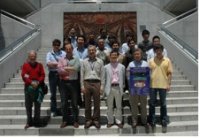 |
 |
|||||||||||||
|
|||||||||||||
|
|||||||||||||
|
The PosiPol2008 workshop was held from 16 to 18 June in Hiroshima, Japan. An unfamiliar word, "PosiPol" stands for "polarised positrons", meaning that the "spins" of positrons are aligned when they meet electrons at the centre of a linear collider. The electron beam is designed to be polarised at the ILC, but according to the baseline configuration positrons are unpolarised (or left naturally polarised) because making polarised positron is a difficult task to do. However, polarised positrons are very useful if we can make them well controlled and highly polarised, strengthening the position of linear colliders as machines to explore the quantum universe. Polarised positrons are created by hitting dense matter with polarised gamma rays. That means that making a high enough number of polarised gamma rays is one of the key techniques. The PosiPol workshop focuses (amongst other things) on so-called laser-Compton-based positron sources in which polarised gamma rays are created by flashing a strong laser at an electron beam. While discussing many issues directly concerning polarised positron sources at linear colliders, possible application of techniques were also an important topic of the workshop. The gamma and X-rays created by the laser-Compton techniques have a wide range of applications in industrial, medical, as well as scientific sectors as reported in a past issue of ILC NewsLine. In this workshop, there was an introduction of a project to create X-rays by a combination of accelerator and sophisticated optical techniques. We also learned about the usefulness of high-flux gamma rays for nuclear waste management. As is getting more and more popular in recent workshops, people who cannot come to the workshop gave talks remotely via an internet connection. In this workshop about a quarter of the talks were given that way. A fast and stable internet connection at the workshop site seems to be essential not only for e-mail connections but more so for the workshop organisation. Though the rainy season had already set in in the Hiroshima area, we had unexpectedly nice weather during the workshop. The present participants enjoyed a walk around downtown Hiroshima and dinner cursing in Setonaikai inland sea in addition to fruitful scientific discussions. The next PosiPol workshop will be hosted by CERN. Participants expect to enjoy good wines in next workshop while we enjoyed many fresh fish from the Hiroshima area this year. -- Tohru Takahashi |
|||||||||||||
| © International Linear Collider |
